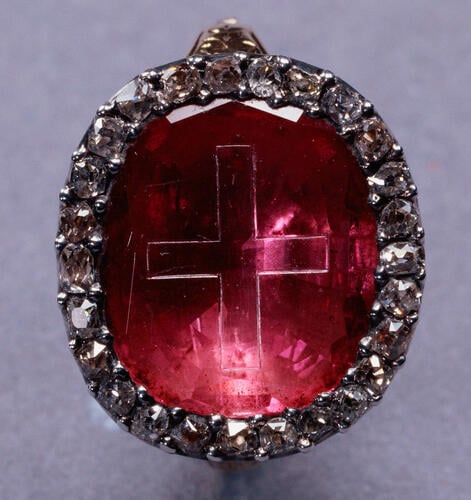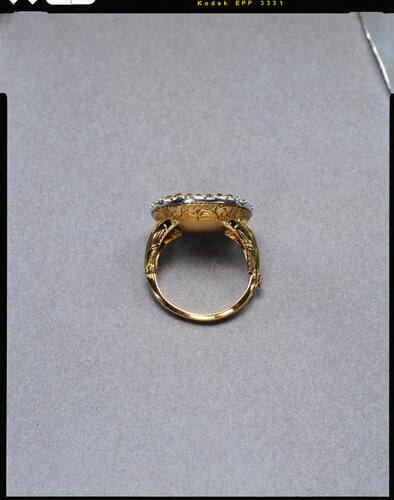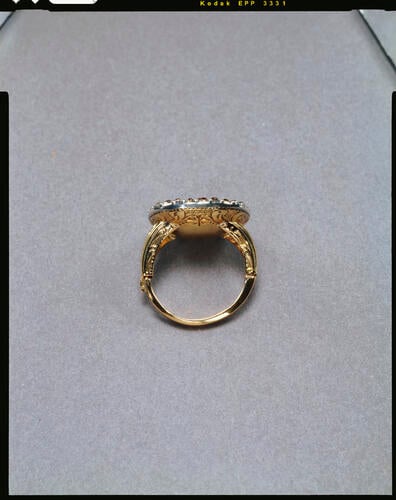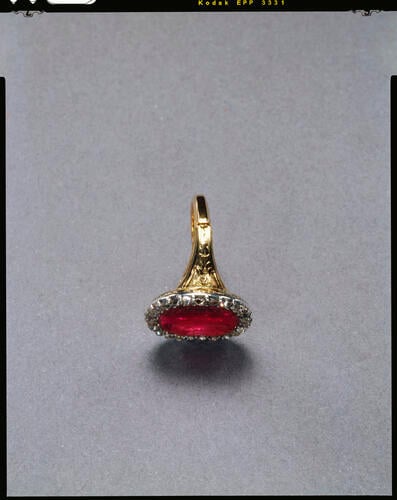-
1 of 253523 objects
Coronation ring c. 1660 or earlier with later additions
Gold, silver, ruby, diamonds | 2.3 x 2.2 cm (whole object) | RCIN 441925







-
Gold coronation ring mounted with a large, flat-cut ruby engraved with the cross of St George with foil behind, surrounded by 26 diamonds set in silver. The ring of polished gold with engraved scrollwork, with engraved shoulders and adjustable shank.
The thin flat-cut ruby is probably one half of a medieval bead that has been cut away and polished to remove the drill hole. The engraved cross is probably seventeenth century. The border of brilliants is a later addition, first referred to in Cardinal York's will; the type of setting supporting the brilliants was in use by 1780. The style and workmanship of the remainder of the ring suggest that it was extensively remodelled for the Prince Regent in the early nineteenth century.
The provenance of this ring remains confused. In 1807, it was bequeathed to George IV, then Prince of Wales, by Cardinal Henry Stuart. At this date it was described in a letter, later transcribed by the Marquess of Abergavenny as 'a ruby ring surrounded by brilliants. On the ruby a cross is engraved. It was used on the coronation day of the Kings of Scotland'. A second paper listed by Abergavenny apparently described the same ring and proclaimed that it may have been used by James I as well as James II. The ring was certainly used at the coronation of James II since it was clearly drawn among the illustrations of Sandford's publication and described as 'a plain Gold Ring, with a large Table Ruby Violet wherein a plain Cross or Cross of St George, was curiously Enchased'.
However, the earlier history is more complex. No ring was listed among the Goldsmiths' Warrants issued for the time of James II's coronation, but this may simply have been because it was considered the personal property of the monarch rather than a piece of regalia. It may also have been the case that James chose to wear his brother Charles's ring for the occasion. A ring was supplied to Charles II in 1661, and was listed in the warrant for coronation regalia although not in the warrants for payment. Moreover, an illustration of Charles II's ring does not offer any suggestion of a cross carved into the ruby, although the drawings, undertaken by Sir Edward Walker, Garter King at Arms, were not wholly reliable in their accuracy. Charles is certainly known to have acquired an 'oriental' ruby valued at £400 in 1661, sold to the Master of the Jewel House, Sir Gilbert Talbot, at that date, 'for His Majties wearing at ye Coronation'. However, the cost suggests a very large stone and may refer to the so-called 'Black Prince's Ruby' (a large spinel) which was placed in the front of the State Crown, probably by the time of Charles II's coronation. If it is likely that James II used his brother's ring at his own coronation in 1685, it may equally be the case that Charles II inherited his father's ring for the same purpose. Cardinal York certainly believed this to be the case, since he apparently allowed the youngest Miss Coutts to try the ring 'which Charles I wore at his Coronation', an incident later recalled by Thomas Coutts in a letter to the Cardinal in January 1800. The link back to James I appears to have been largely disregarded after 1887 and his name does not appear to have been associated with the ring since.
The practice of investing the sovereign with a ring on the fourth finger of the right hand, following the crowning but before receiving the sceptre, was continued after the Restoration. A contemporary description relates how, during the coronation of James II, the Archbishop of Canterbury put the ring 'on the fourth finger of His Majesties right hand, saying, Receive the ring of Kingly Dignity and the seal of Catholick Faith, that thou are this day consecrated head and prince of this kingdom and people'. The King was then presented with a richly decorated glove which he wore on his right hand over the ring.
The absence of Charles II's coronation ring from the accounts raises the intriguing possibility that he used his father's ring. Certainly Cardinal York believed that this ring was Charles I's: in a letter written to the Cardinal in January 1800, Thomas Coutts recalled how he had afforded the youngest Miss Coutts 'the distinguished honour' of putting on 'the ring which Charles I wore at his Coronation'. The ring was ambiguously described as 'King Charles's Coronation Ring' when it was listed at Windsor Castle in 1830.
Whatever its early history, the ring may be firmly associated with James II, who took it into exile with him in 1688. It is listed in his posthumous inventory drawn up at Saint-Germain on 20 July 1703 as 'One Ruby Ring having a Cross ingraved on it wth which the Late King was crowned'. In 1715 the ring was included in an inventory of the goods of his widow, Mary of Modena, dispatched from Paris. Following her death in 1718, the ring remained in the Stuart family until the early nineteenth century when it was bequeathed in the will of Cardinal York to the Prince of Wales in 1807. It was finally delivered to George IV in 1815 and appears in an 1830 inventory of jewellery at Windsor Castle, where its ambiguous history is upheld by the description 'King Charles's Coronation Ring'. In 1830 William IV deposited the ring on loan to be displayed with the Honours of Scotland in Edinburgh Castle.
Text adapted from Ancient and Modern Gems and Jewels in the Collection of Her Majesty The Queen, London, 2008 and Charles II: Art and Power (2017).Provenance
?Charles I; ?Charles II; James II; Mary of Modena; thence by descent to Prince Henry Benedict Stuart, Cardinal York; by whom bequeathed to George IV when Prince of Wales, 1807.
-
Creator(s)
(nationality)Acquirer(s)
-
Medium and techniques
Gold, silver, ruby, diamonds
Measurements
2.3 x 2.2 cm (whole object)
Category
Object type(s)